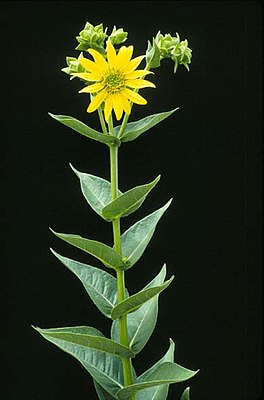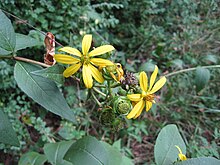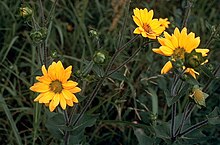Silphien
| Silphien | ||||||||||||
|---|---|---|---|---|---|---|---|---|---|---|---|---|

|
||||||||||||
| Systematics | ||||||||||||
|
||||||||||||
| Scientific name | ||||||||||||
| Silphium | ||||||||||||
| L. |
The Silphien ( Silphium ) are a genus of plants that belongs to the subfamily of the Asteroideae in the sunflower family (Asteraceae). The home is North America .
description

Silphium species are perennial herbaceous plants that reach heights of 20 to over 250 cm. They form rhizomes and fiber roots or tap roots. The mostly upright and mostly branched stems are pencil-shaped or square. The whorled, alternate, almost or completely opposite, basal or distributed on the stem (sometimes all these possibilities on one plant) leaves remain for a long time or wither before the flowering period. They are stalked or sessile. The leaf blades are single or one to two pinnate depending on the species . There are one to three leaf veins . The leaf margins are smooth or serrated . The leaf surfaces are smooth to hairy.
Cup -shaped inflorescences are formed singly or in branched whole inflorescences . The bell-shaped to hemispherical flower heads have a diameter of 10 to 30 mm. The usually 11 to 45 bracts are in two to more than four rows; the outer ones are wider, the inner ones smaller and narrower. The inflorescence base is flat to slightly convex. There are chaff leaves. Each flower head contains eight to more than 35 ray-florets in one to four rows and 20 to more than 200 tubular florets . The female and fertile ray florets (= ray florets) are yellow or white. The functionally male tubular flowers (= disc flowers) are also yellow or white with a much shorter than wide corolla tube that ends in five calyx teeth.
The brown to black, more or less angular achenes have only one pappus of only two bristles that more or less merge into the achenes' edges or it is completely absent.

Systematics and distribution
The genus Silphium was published in 1753 by Carl von Linné in Species Plantarum on page 919. Five species are already listed there, of which Silphium solidaginoides L. today bears the valid name Heliopsis helianthoides (L.) Sweet . The generic name Linnaeus chose with reference to the Latin plant names silphium , the Greek name silphion σίλφιον back, who described a North African medicinal plant in ancient Greece, it was probably a Ferula -Art. The genus Silphium belongs today to the subtribe Engelmanniinae in the tribe Heliantheae in the subfamily of the Asteroideae within the family of the daisy family (Asteraceae).
In the genus Silphium there are now about 12, previously up to 22 species, they are sometimes better viewed as varieties. They are all native to the temperate areas of North America. Individual species reached Europe as early as the end of the 17th century and a few more during the 18th century. The cup plant ( Silphium perfoliatum L. ) was used as an ornamental plant and has grown wild in some areas.
The species valid today are:
- Silphium albiflorum A.Gray : It is only found in Texas.
- Silphium asteriscus L .: It occurs in five varieties in the eastern United States.
- Silphium brachiatum Gatt . : It occurs in Alabama, Georgia and Tennessee.
- Silphium compositum Michx. : It occurs in West Virginia, Alabama, Florida, Georgia, North Carolina, South Carolina, Tennessee, and Virginia.
- Silphium glutinosum J.R. Allison : It is only found in Alabama.
- Silphium integrifolium Michx. : It occurs in Ontario and in the United States.
- Compass plant ( Silphium laciniatum L. ): It is native to the United States and Canada.
- Silphium mohrii Small : Found in Alabama, Georgia, and Tennessee.
- Cup plant or streaky silphie ( Silphium perfoliatum L. ): It is native to the United States and Canada. In Europe the species is a neophyte.
- Silphium radula Nutt. : It occurs in two varieties in Kansas, Missouri, Oklahoma, Texas, Arkansas, and Louisiana.
- Silphium terebinthinaceum Jacq. : The home is the United States.
- Quirlblättrige Silphie ( Silphium trifoliatum L. ): Home is the United States.
- Silphium wasiotense M. Medley : It occurs in Kentucky and Tennessee.
No longer belong to the genus:
- Silphium peristenium Raf. ⇒ Engelmannia peristenia (Raf.) Goodman & CALawson
- Silphium trilobatum L. ⇒ Sphagneticola trilobata (L.) Pruski
swell
- Jennifer A. Clevinger: Silphium in Flora of North America , Volume 21, p. 83: Online. (engl.)
Individual evidence
- ↑ a b c d e f g Jennifer A. Clevinger: Silphium Linnaeus. In: Flora of North America, vol. 21. [1] .
- ↑ a b c d e f g h i j Silphium in the Germplasm Resources Information Network (GRIN), USDA , ARS , National Genetic Resources Program. National Germplasm Resources Laboratory, Beltsville, Maryland. Retrieved March 3, 2018.
Web links
- Entry in Plants for a Future. (engl.)

